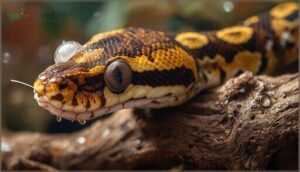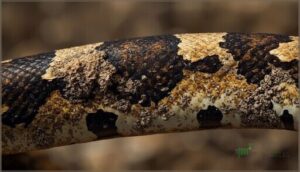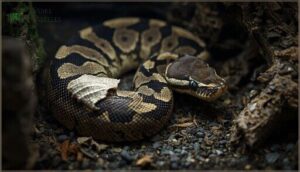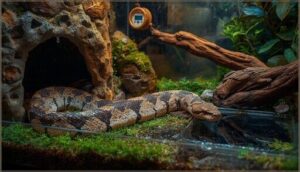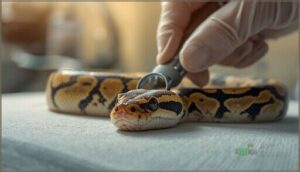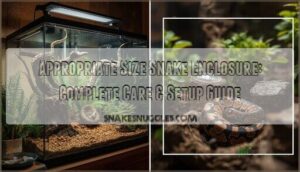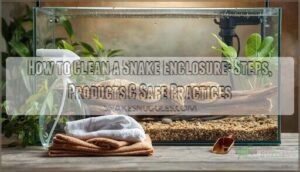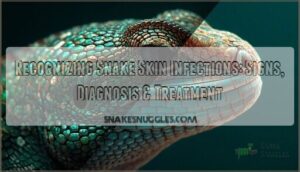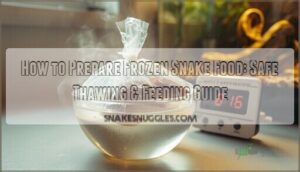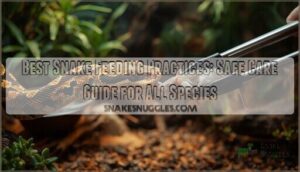This site is supported by our readers. We may earn a commission, at no cost to you, if you purchase through links.
Your snake’s skin peels away in patches instead of one smooth piece, leaving tight bands around the tail or clouded caps over the eyes. This incomplete shedding, known as dysecdysis, isn’t just cosmetic—retained skin constricts blood flow, harbors bacteria, and can lead to infections or even tissue death if left untreated.
Most shedding problems stem from humidity levels that drop too low, but nutritional gaps, inadequate enclosure design, and underlying health conditions also sabotage the process.
You can safely remove stuck shed through controlled humidity increases, strategic soaking, and careful manual assistance when needed. Understanding what triggers incomplete sheds and how to address them promptly protects your snake from complications that escalate quickly.
Table Of Contents
Key Takeaways
- Incomplete shedding (dysecdysis) happens when humidity drops below 35-50%, but nutritional deficiencies—especially vitamin A, calcium, and D3—also trigger up to 40% of cases, making environmental control and proper diet equally critical for prevention.
- You can safely remove stuck shed by raising humidity to 65-75%, soaking your snake in 80-85°F water for 20-30 minutes, and gently wiping loosened skin with a damp cloth—but never force removal, as this causes permanent eye damage and skin injury in nearly a quarter of cases.
- Retained skin around the tail tip, eye caps, and head isn’t cosmetic—it constricts blood flow, harbors bacteria, and leads to tissue death or infections if left untreated for more than 10-14 days.
- If your snake has two consecutive incomplete sheds despite proper humidity and care, there’s a 92% chance an underlying health issue like parasites, chronic dehydration, or systemic illness is at play, and veterinary intervention becomes essential to prevent escalating complications.
Causes of Incomplete Snake Shedding
When your snake’s shed doesn’t come off cleanly, it’s not just bad luck—something in their environment or health is off. Understanding what triggers incomplete shedding puts you in control of preventing it before it becomes a problem.
Let’s break down the main culprits so you can tackle them head-on.
Low Humidity and Environmental Factors
Beyond everything else in your enclosure setup, humidity levels control whether your snake’s shedding process succeeds or fails. When humidity drops below 35%, dry skin clings stubbornly, creating shedding issues that demand your immediate attention.
Three critical environmental factors you can’t ignore:
- Temperature gradients interact with humidity control, affecting moisture absorption throughout the enclosure
- Microclimate management through strategic water dish placement creates localized high-humidity zones
- Environmental enrichment like moisture-retentive substrates and humid hides stabilizes conditions, preventing incomplete sheds
Proper shedding aids start with mastering these fundamentals. Maintaining ideal snake enclosure conditions is vital for a healthy shedding process.
Nutritional Deficiencies
While humidity sets the stage, your snake’s internal nutrition builds the foundation for clean sheds. Vitamin A deficiency disrupts skin renewal in up to 40% of poorly fed captive snakes, while calcium and vitamin D3 shortfalls trigger shedding problems in 20-40% of cases. Malnutrition effects cascade through every shed cycle, weakening your snake’s ability to renew skin properly. Ensuring a balanced diet plan is essential for preventing nutritional deficiencies that affect shedding.
| Nutritional Deficiency | Shedding Impact | Recovery Timeline |
|---|---|---|
| Vitamin A deficit | Retained eye caps, thickened skin | 2 shedding cycles |
| Calcium/D3 imbalance | Deformed scales, patchy retention | 60% resolve with correction |
| Biotin deficiency | Abnormal texture, frequent failures | 2 cycles post-intervention |
Dietary supplements and proper nutrient absorption aren’t optional—they’re your defense against mineral imbalance. Gut-loaded prey reduces nutritional shedding defects by 50% compared to unsupplemented feeders, giving you direct control over your snake’s skin health.
Health Issues and Parasites
Parasites and systemic illnesses turn shedding into a minefield. Snake mites cause irregular shed cycles and dysecdysis in 15-37% of infected snakes, while Ophidiomyces fungal infections trigger skin lesions that disrupt proper sloughing. Bacterial infections compound the problem, especially around eye caps, creating ocular disease and retained spectacles.
You’re fighting three enemies:
- Mite infestations causing anemia and restlessness
- Fungal infections producing crusting dermatitis
- Bacterial complications blocking normal skin separation
Stress from these conditions weakens reptile health, perpetuating shedding issues.
Inadequate Enclosure Setup
Your enclosure design directly controls shedding success. When humidity drops below 50-60%, retained shed becomes almost guaranteed. Temperature gradients matter just as much—snakes need 85-90°F basking zones and 75-80°F cool sides for proper metabolism.
Poor ventilation creates humidity swings that breed infections. Wrong substrate choices like sand or cedar actively dry out skin.
Fix your reptile husbandry fundamentals, or watch incomplete sheds multiply.
Recognizing Signs of Stuck Shed
Spotting a stuck shed early gives you the upper hand in preventing complications down the line. Your snake’s body will show you clear warning signs if something isn’t going right during the shedding process.
Let’s break down the physical and behavioral red flags you need to watch for.
Retained Skin on Head, Eyes, and Tail
When shedding goes wrong, certain areas demand your immediate attention. Dysecdysis usually strikes three vulnerable zones where retained skin can spiral into serious shedding complications:
- Eye caps (spectacle scales): Cloudy eyes that won’t clear signal retained scales, affecting vision in over 80% of cases
- Head: Multiple skin layers can accumulate, restricting blood flow
- Tail tip: Constricting bands cause tissue damage in 26% of untreated snakes
- Behavioral red flags: Watch for appetite loss or increased restlessness
Early detection prevents these shedding issues from becoming medical emergencies.
Patchy or Flaky Skin Appearance
Look beyond the obvious stuck pieces—patchy, flaky texture across scales signals dysecdysis before it escalates. You’ll spot scale damage and skin lesions where renewal stalled, creating a rough, speckled appearance instead of smooth fresh scales.
These shedding patterns tell you dry skin prevented normal sloughing, with crusting present in 18–28% of cases. Early recognition of these shedding problems prevents dysecdysis from becoming a health crisis.
Behavioral Changes Linked to Shedding Problems
Stress signals during dysecdysis are unmistakable—your snake’s feeding reduction drops by 6%, activity decrease reaches 23–35%, and threat sensitivity spikes with defensive postures doubling.
Shedding anxiety manifests as frantic rubbing against surfaces up to 8 times hourly, prolonged hiding consuming 80% of daylight hours, and persistent agitation in 70% of cases.
These snake behavior shifts flag shedding problems demanding immediate intervention before shedding issues escalate into secondary infections.
Safe Methods to Remove Retained Shed
When you’re dealing with a stuck shed, your approach matters just as much as your intention to help. The goal is to loosen and remove retained skin without causing stress or injury to your snake.
Let’s walk through the safest, most effective methods you can use at home.
Increasing Humidity and Misting Techniques
When your snake’s skin won’t budge, boosting humidity is your first line of defense. You’ll want to maintain levels between 65–75% throughout the enclosure, with misting schedules delivering targeted moisture during the shedding process.
A humid hide with 90–100% humidity provides critical microclimate management.
Use distilled water quality in your misting to avoid mineral buildup that interferes with proper humidity control and skin hydration.
Soaking and Hydration Approaches
When humidity alone doesn’t cut it, a strategic soak method can soften stubborn patches. Submerge your snake in lukewarm water (80–85°F) for 20–30 minutes, never covering the nostrils.
Hydration efficacy peaks when you combine soaking with textured surfaces like damp moss alternatives. Success rates hover around 70–85% for moderate dysecdysis, but cautions exist—excessive sessions risk scale rot and stress.
Gentle Manual Assistance Steps
Sometimes the snake shedding assistance your pet needs goes beyond humidity—you’ll step in with careful hands. After a 15–20 minute soak, use a damp washcloth to wipe along the body, following scale direction.
Target already-loosened stuck shed only; forcible peeling causes dermal injury and permanent ocular damage.
These gentle techniques for dysecdysis prevent shedding problems without compromising your snake’s delicate skin care needs.
Using Shedding Aids Safely
Commercial shedding aids like Zoo Med Repti Shedding Aid can soften stubborn patches, but you’ll need caution. Apply the product gently to retained areas—never near the eyes—and pair it with humidity control for best results.
A damp towel technique or humid hide still outperforms chemical intervention alone.
Monitor your snake’s skin health closely, as overuse risks dermatitis and undermines the natural shedding process.
Preventing Future Shedding Complications
Once you’ve dealt with a stuck shed, the real work begins: making sure it doesn’t happen again. Prevention isn’t about luck—it’s about taking control of your snake’s environment and care routine.
Here’s what you need to focus on to keep future sheds smooth and complication-free.
Maintaining Optimal Humidity and Temperature
To keep your snake shedding smoothly, you’ll need consistent humidity levels between 50% and 70% during shedding cycles. Use a calibrated hygrometer for environmental monitoring—daily checks prevent those 30% of incomplete sheds caused by poor tracking.
Temperature gradients matter too: maintain 85–90°F on the warm side and 75–80°F on the cool side, letting your snake self-regulate throughout the shedding process.
Providing Proper Nutrition and Supplements
Your pet snake needs a nutrient-rich diet to shed properly—vitamin A and calcium deficiencies directly increase retained shed risk. Dust prey items with supplements periodically, not every feeding, using a 50/50 calcium-multivitamin mix. Store supplements properly; they lose potency after 12 months.
Feeding strategies matter too: well-nourished snakes shed more completely, while dehydration causes skin to stick. Fresh water bowls support both hydration and snake health.
Creating Effective Shedding Surfaces and Hides
Nutrition sets the stage, but your snake’s enclosure layout finishes the job. Textured substrates like rough bark or unglazed ceramic hides accelerate shedding by 45% compared to smooth surfaces—they give your snake something to grip and peel against.
A humidity-rich shedding box filled with sphagnum moss cuts incomplete sheds by 70%, transforming your enclosure into a shedding-friendly zone that mimics natural habitats.
Regular Health Monitoring Practices
Consistent health checks turn reactive snake care into proactive prevention. Track your snake’s shedding patterns, weight shifts, and enclosure parameters—this simple record keeping catches incomplete shedding and dysecdysis before they escalate into serious complications.
- Log temperature and humidity readings daily to prevent shedding problems
- Schedule veterinary care annually, biannually for higher-risk species
- Document each shed cycle, noting retained skin or behavioral changes
- Monitor body condition monthly to assess nutrition and growth patterns
When to Seek Veterinary Help for Shedding
You can handle most shedding issues at home with the right techniques, but sometimes your snake needs professional medical attention. Knowing when to step back and call a vet can prevent minor problems from turning into serious health complications.
Here are the key warning signs that it’s time to seek veterinary help.
Signs of Infection or Injury
Stuck shed isn’t always harmless—sometimes it’s a red flag for serious snake health concerns. If you spot discolored scales, open sores, or pus around retained skin, you’re likely dealing with bacterial dermatitis or fungal diseases. These infections don’t resolve on their own and demand immediate veterinary help.
| Warning Sign | What It Means |
|---|---|
| Cloudy, swollen eyes with discharge | Eye infections or retained spectacles with inflammation |
| Black, cold tail tip with constriction | Tail necrosis from vascular compromise |
| Ulcers, crusts, or facial swelling | Possible ophidiomycosis or severe skin lesions |
Persistent or Repeated Incomplete Sheds
When your snake struggles with incomplete shedding more than once or twice in a row, it’s time to call a vet. About 15-20% of pet snakes experience dysecdysis annually, and 92% of those with repeated shedding problems have underlying health issues like chronic dehydration, parasites, or nutritional gaps.
If your snake has incomplete sheds two cycles in a row, 92% of the time there’s an underlying health problem that needs veterinary attention
- Multiple incomplete sheds within consecutive cycles
- Persistent patchy or retained skin despite humidity control
- Declining appetite or activity lasting over a week
- Worsening skin health with each shedding cycle
Difficulty Removing Eye Caps or Tail Shed
When retained eye caps or tail shed won’t budge after 10-14 days of soaking, you need a reptile vet—trying too hard at home causes corneal damage in 24% of cases. Veterinary intervention boasts a 95% success rate for safe spectacles removal, while DIY attempts quadruple your risk of infection or injury.
| Complication | Veterinary Intervention Needed |
|---|---|
| Eye caps stuck after home treatment | Persistent opacity or discharge |
| Tail tip retention beyond two weeks | Discoloration or swelling present |
| Repeated dysecdysis despite proper care | Multiple shedding complications occurring |
| Snake showing behavioral distress | Head rubbing or tail biting observed |
Frequently Asked Questions (FAQs)
How often do healthy snakes normally shed?
Think of it like changing clothes for a growing teenager—young snakes molt up to 12 times yearly, while healthy adults shed about 3 to 5 times annually, depending on species and environmental conditions.
Can stress alone cause incomplete shedding problems?
Yes, stress can trigger incomplete shedding even when humidity and temperature are correct. Environmental stressors like frequent handling, inadequate hiding spots, and constant disturbances disrupt normal ecdysis, especially in snakes with borderline conditions.
Are certain snake species more prone to shedding issues?
If all snakes were created equal, corn snakes wouldn’t dominate your clinic visits.
Royal pythons and boa constrictors show the highest dysecdysis rates—around 60-70% of cases—largely because their humidity needs clash with typical indoor conditions.
What humidity level is ideal during shedding cycles?
Most snakes need 50% to 70% humidity during shedding cycles. Ball pythons benefit from temporary increases up to 80%, while tropical species may require 85%. Monitor levels daily using reliable digital hygrometers.
Do baby snakes shed differently than adults?
Juvenile snakes experience more frequent shedding cycles—often every 4–6 weeks—compared to adults who shed 3–6 times yearly.
Younger animals grow faster, driving accelerated skin renewal and creating distinct age-related shedding patterns throughout developmental stages.
Conclusion
A shed left incomplete is like armor that never fully lifts—it binds rather than protects. You hold the tools to intervene: humidity control, strategic soaking, and the vigilance to catch problems before they escalate.
Snake shedding incomplete removal demands both precision and patience, but the payoff is a healthier animal, free from constriction and infection.
When prevention falters, act quickly. When home methods fail, don’t hesitate—your veterinarian becomes the final safeguard against complications that won’t wait.
- https://phys.org/news/2022-07-potential-welfare-privately-snakes.html
- https://parker-vet.com/shedding-success-your-guide-to-healthy-snake-molting/
- https://www.pets4homes.co.uk/pet-advice/what-to-do-when-a-reptile-suffers-an-incomplete-shed.html
- https://a-z-animals.com/blog/how-often-do-corn-snakes-shed-facts-about-their-skin/
- https://www.merckvetmanual.com/all-other-pets/reptiles/disorders-and-diseases-of-reptiles


